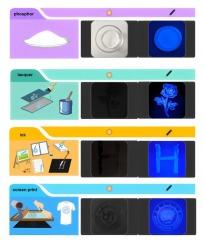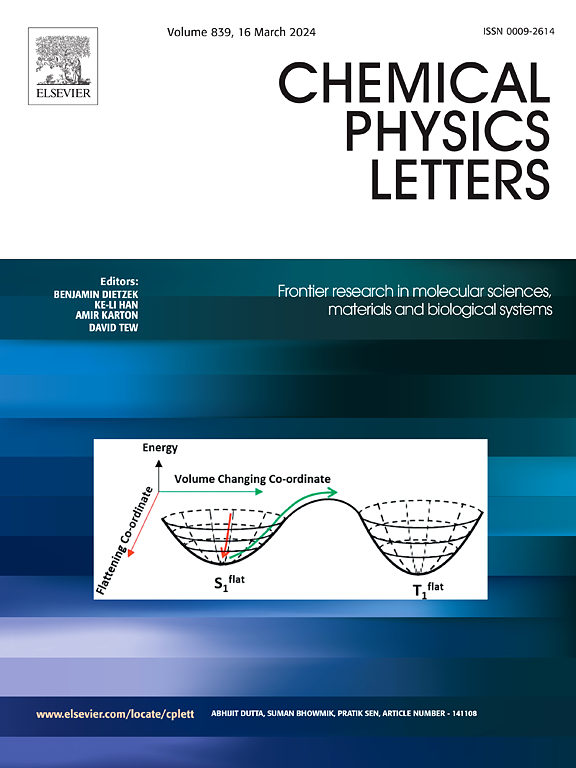Eu2+掺杂K-β-Al2O3蓝色荧光粉的发光特性及其防伪应用研究
IF 3.1
3区 化学
Q3 CHEMISTRY, PHYSICAL
引用次数: 0
摘要
采用高温固相法合成了Eu2+掺杂K-β-Al2O3蓝色荧光粉。采用XRD、SEM和荧光光谱分析对样品的晶体结构、微观结构和光致发光性能进行了表征。结果表明,在Eu2+掺杂浓度范围内,合成产物保持单一的K-β-Al2O3相,并且随着Eu2+掺杂浓度的增加,晶格常数逐渐降低,表明Eu2+离子占据了主体晶体结构导电层中的K+位。合成的荧光粉呈六角形片状,粒径均匀,分散性能优良。在345 nm近紫外光激发下,光致发光光谱呈现单峰窄带发射,发射峰以445 nm为中心,该发射源于Eu2+的4f - 5d能级跃迁。随着Eu2+掺杂浓度的增加,荧光粉的发光强度呈先上升后下降的趋势。当Eu2+掺杂浓度达到7 mol%时,发光强度达到最大。此外,合成的荧光粉表现出优异的热稳定性,在423 K时保持了76.5%的初始强度。在345 nm近紫外光激发下,K1-xAl11O17: xEu2+荧光粉的色坐标位于蓝光区边界,色纯度超过98%,接近纯蓝色。以花王:0.07Eu2+蓝色荧光粉和环氧树脂胶配制的防伪油墨,应用于图案后,可达到理想的防伪效果。本文章由计算机程序翻译,如有差异,请以英文原文为准。

Study on luminescence properties of Eu2+ doped K-β-Al2O3 blue phosphor and its anti-counterfeiting application
Eu2+ doped K-β-Al2O3 blue phosphors were synthesized via the high temperature solid-state method. The crystal structure, microstructure and photoluminescence properties of the samples were characterized using XRD, SEM and fluorescence spectrum analysis. The results indicate that within the Eu2+ doping concentration range, the synthesized products maintain a single K-β-Al2O3 phase, and the lattice constant gradually decreases as the Eu2+ doping concentration increases, suggesting that Eu2+ ions occupy the K+ sites in the conductive layer of the host crystal structure. The synthesized phosphor exhibits a hexagonal flake morphology, with uniform particle size and excellent dispersion performance. Under 345 nm near ultraviolet light excitation, the photoluminescence spectra display a single-peak narrow-band emission, with the emission peak centered around 445 nm, this emission originates from the 4f - 5d energy level transition of Eu2+. as the Eu2+ doping concentration increases, the luminescence intensity of phosphors increases first rises and then declines. The maximum luminescence intensity is achieved when the Eu2+ doping concentration reaches 7 mol%. Moreover, the synthesized phosphors demonstrate excellent thermal stability, retaining 76.5 % of their initial intensity at 423 K. The color coordinates of K1-xAl11O17: xEu2+ phosphors are situated at the boundary of the blue light region under 345 nm near-ultraviolet light excitation, with a color purity exceeding 98 %, approaching pure blue. An anti-counterfeiting ink formulated with KAO: 0.07Eu2+ blue phosphor and epoxy resin glue can achieve ideal anti-counterfeiting effect after when applied to patterns.
求助全文
通过发布文献求助,成功后即可免费获取论文全文。
去求助
来源期刊

Chemical Physics Letters
化学-物理:原子、分子和化学物理
CiteScore
5.70
自引率
3.60%
发文量
798
审稿时长
33 days
期刊介绍:
Chemical Physics Letters has an open access mirror journal, Chemical Physics Letters: X, sharing the same aims and scope, editorial team, submission system and rigorous peer review.
Chemical Physics Letters publishes brief reports on molecules, interfaces, condensed phases, nanomaterials and nanostructures, polymers, biomolecular systems, and energy conversion and storage.
Criteria for publication are quality, urgency and impact. Further, experimental results reported in the journal have direct relevance for theory, and theoretical developments or non-routine computations relate directly to experiment. Manuscripts must satisfy these criteria and should not be minor extensions of previous work.
 求助内容:
求助内容: 应助结果提醒方式:
应助结果提醒方式:


